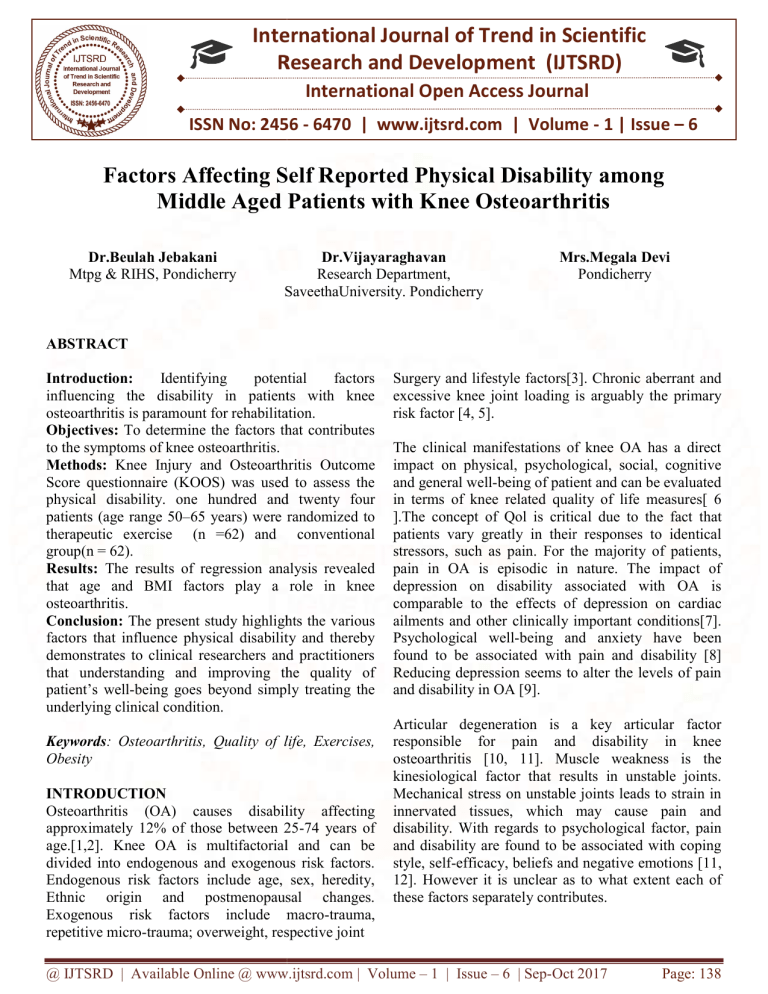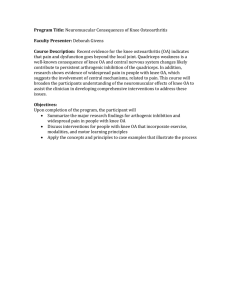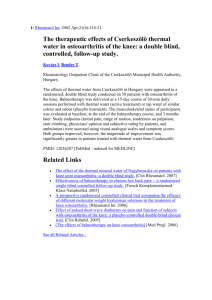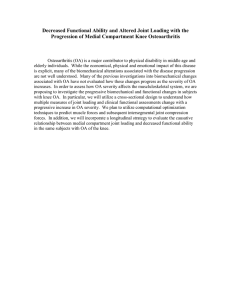
International Journal of Trend in Scientific
Research and Development (IJTSRD)
International Open Access Journal
ISSN No: 2456 - 6470 | www.ijtsrd.com | Volume - 1 | Issue – 6
Factors Affecting Self Reported Physical Disability among
Middle Aged Patients with
ith Knee Osteoarthritis
Dr.Beulah Jebakani
Mtpg & RIHS, Pondicherry
Dr.Vijayaraghavan
Research Department,
SaveethaUniversity. Pondicherry
Mrs.Megala Devi
Pondicherry
ABSTRACT
Introduction:
Identifying
potential
factors
influencing the disability in patients with knee
osteoarthritis is paramount for rehabilitation.
Objectives: To determine the factors that contributes
to the symptoms of knee osteoarthritis.
Methods: Knee Injury and Osteoarth
Osteoarthritis Outcome
Score questionnaire (KOOS) was used to assess the
physical disability. one hundred and twenty four
patients (age range 50–65
65 years) were randomized to
therapeutic exercise (n =62) and conventional
group(n = 62).
Results: The results of regression
ression analysis revealed
that age and BMI factors play a role in knee
osteoarthritis.
Conclusion: The present study highlights the various
factors that influence physical disability and thereby
demonstrates to clinical researchers and practitioners
that understanding
nderstanding and improving the quality of
patient’s well-being
being goes beyond simply treating the
underlying clinical condition.
Keywords: Osteoarthritis, Quality of life, Exercises,
Obesity
INTRODUCTION
Osteoarthritis (OA) causes disability affecting
approximately 12% of those between 25
25-74 years of
age.[1,2]. Knee OA is multifactorial and can be
divided into endogenous and exogenous risk factors.
Endogenous risk factors include age, sex, heredity,
Ethnic origin and postmenopausal changes.
Exogenous risk factors include macro
macro-trauma,
repetitive micro-trauma;
trauma; overweight, respective joint
Surgery and lifestyle factors[3]. Chronic aberrant and
excessive knee joint loading is arguably the primary
risk factor [4, 5].
The clinical manifestations of knee OA has a direct
impact on physical, psychological, social, cognitive
and general well-being
being of patient and can be evaluated
in terms of knee related quality of life measures[ 6
].The concept of Qol is critical
critica due to the fact that
patients vary greatly in their responses to identical
stressors, such as pain. For the majority of patients,
pain in OA is episodic in nature. The impact of
depression on disability associated with OA is
comparable to the effects of depression on cardiac
ailments and other clinically important conditions[7].
Psychological well-being
being and anxiety have been
found to be associated with pain and disability [8]
Reducing depression seems to alter the levels of pain
and disability in OA [9].
Articular degeneration is a key articular factor
responsible for pain and disability in knee
osteoarthritis [10, 11]. Muscle weakness is the
kinesiological factor that results in unstable joints.
Mechanical stress on unstable joints leads to strain in
innervated
ervated tissues, which may cause pain and
disability. With regards to psychological factor, pain
and disability are found to be associated with coping
style, self-efficacy,
efficacy, beliefs and negative emotions [11,
[11
12]. However it is unclear as to what extent each
eac of
these factors separately contributes.
@ IJTSRD | Available Online @ www.ijtsrd.com | Volume – 1 | Issue – 6 | Sep-Oct
Oct 2017
Page: 138
International Journal of Trend in Scientific Research and Development (IJTSRD) ISSN: 2456-6470
Methods
This is a part of research study conducted from April
2012 to December 2013 at Physical Medicine &
Rehabilitation Centre.
Study design and study population
A total of 124 patients were recruited and due to 6
dropouts during the intervention period, final analysis
was done with 118 participants. The study population
was randomly divided into a conventional
physiotherapy and therapeutic exercise group
respectively comprising of 59 patients each. Patients
of diagnosed unilateral knee OA in the age group 5065 years with sufficient English/Tamil language skills
to complete the assessment tools were included in the
study.
Patients with neurological diseases, hypertensive
patients,
those
with
uncontrolled
cardiopulmonary/respiratory diseases, patients unable
to rise from and return to a chair without assistance,
those with any additional muscular skeletal
diseases/surgeries, psychiatric illness and liability to
co-operate were excluded from the study.
Demographic data [age, gender, body mass index
(BMI), duration of disease & educational status] was
obtained. Physical Disability was measured using
KOOS scale. KOOS scale measures pain, symptoms,
physical function, sport and recreation function, and
knee-related quality of life. Standard versions of the
KOOS scale were available for free in both English
and Tamil. (http://www.koos.nu). The internal
consistency range in knee osteoarthritis patients for
KOOS Pain was 0.65–0.94, for KOOS Symptoms was
0.56–0.83, for KOOS Activities for Daily Living
(ADL) was 0.78–0.97, for KOOS Sport/Rec: 0.84–
0.98, and for KOOS Quality of Life (QOL) was 0.71–
0.85[13].
Interventions: The treatment protocol for therapeutic
exercise physiotherapy program was framed based on
current published treatment recommendations of
exercise programs for knee Osteoarthritis by
American College of Rheumatology Subcommittee on
Osteoarthritis Guidelines [14], American Geriatrics
society [15], and evidence-based recommendations of
an expert panel on delivering exercise therapy to knee
OA patients [16].
Statistical analysis: For analysis of various factors
affecting the parameters under study, logistic
regression was used.
Ethical committee consideration
The study was approved by the Ethical committee.
Letter of permission was taken from respective
administration. Written informed participants were
obtained. Privacy and confidentiality was maintained
throughout the study period.
Results
The study included 118 participants after eliminating
the dropouts. The age of the patients varied from 5065 years of age with maximum number of patients
were in the age group of 50-55 years. A high
percentage (80.5%) of the participants was
overweight with a BMI ≥ 25. The entire study group
was educated and had received a minimum of high
school education. Table 1 demonstrates the split up of
the demographic data.
Table1: Demographic characteristics
Variables
Therapeutic Exercise
Conventional Physiotherapy
Age (in Yrs)
50-55
29
25
56-60
23
18
61-65
7
16
Gender
Male
28
19
Female
31
40
BMI
18.6-24
12
11
@ IJTSRD | Available Online @ www.ijtsrd.com | Volume – 1 | Issue – 6 | Sep-Oct 2017
Page: 139
International Journal of Trend in Scientific Research and Development (IJTSRD) ISSN: 2456-6470
25-29
23
31
≥30
24
17
Duration (in Yrs)
3-6
38
31
7-12
21
28
Education
High School
39
44
Secondary
9
2
Graduate
11
13
Logistic regression analysis showed age (p=0.043) to be a significant factor in predicting mean pain KOOS score in the
therapeutic exercise group (table 2) while none of the factors seemed to influence the pain KOOS score in the
conventional group.
Table 2: Logistic Regression table showing the factors affecting physical disability(KOOS)-Pain
Therapeutic
Group
Factors
Age
Gender
Occupation
Education
Pain
Site
Side
BMI
Constant
Duration
Total
Conventional Age
Group
Gender
Education
Occupation
Pain
Site
Side
BMI
Duration
B
1.311
-1.654
-1.810
-.755
1.228
.243
-.468
.290
1.419
.906
-.965
-.155
-20.1
.165
-20.1
-1.460
.555
.246
.654
.035
S.E.
.648
1.200
1.097
.743
.668
.377
.676
.412
3.582
.693
.781
Wald
4.085
1.900
2.722
1.033
3.381
.416
.478
.496
.157
1.710
1.525
p
0.043
.168
.099
.309
.066
.519
.489
.481
.692
.191
.217
.445
14608
.838
14608
.969
.406
.715
.557
.709
.121
.000
.039
.000
2.269
1.870
.118
1.378
.002
.728
.999
.844
.999
.132
.172
.731
.240
.960
OR
3.709
.191
.164
.470
3.415
1.275
.626
1.337
4.134
2.474
.381
.857
.000
1.179
.000
.232
1.742
1.278
1.923
1.036
95%
C.I.forEXP(B)
Lower Upper
1.041
13.219
.018
2.010
.019
1.405
.110
2.015
.922
12.648
.609
2.670
.166
2.358
.596
3.000
.636
.082
.358
.000
.228
.000
.035
.786
.315
.645
.258
9.617
1.762
2.049
6.096
1.552
3.860
5.189
5.730
4.161
Regression analysis of the factors affecting KOOS symptom subscale showed that the duration of the pain
@ IJTSRD | Available Online @ www.ijtsrd.com | Volume – 1 | Issue – 6 | Sep-Oct 2017
Page: 140
International Journal of Trend in Scientific Research and Development (IJTSRD) ISSN: 2456-6470
(p=0.004) was a significant predictor of KOOS symptom subscale in the therapeutic group. Age (p=0.049) was
a significant factor influencing the KOOS- symptom subscale in the conventional group.(Table 3)
Table 3: Logistic regression table showing the factors affecting physical disability (KOOS) –Symptom
Group
Factors
B
S.E.
Wald
p
OR
Age
-.748
.576
1.682
.195
.474
Therapeutic Gender
group
Occupation
Education
Pain
Site
Side
BMI
Constant
Duration
Total
.225
1.636
-.535
1.481
.040
.022
.532
-8.039
2.273
-.988
.925
.890
.807
.785
.393
.703
.424
3.599
.782
.865
.059
3.383
.439
3.555
.010
.001
1.576
4.990
8.441
1.306
.808
.066
.508
.059
.920
.975
.209
.025
0.004
.253
1.253
5.136
.586
4.396
1.040
1.022
1.703
.000
9.709
.372
Conventiona
l group
-1.397
1.400
-.921
.653
.618
.499
-.262
.710
1.064
1.151
.489
.916
.625
.943
3.874
1.731
.641
1.785
.455
.638
.077
0.049
.188
.424
.182
.500
.424
.781
.247
4.056
1.647
1.921
1.855
1.647
.769
Age
Education
Pain
Site
Side
BMI
Duration
95% C.I.forEXP(B)
Lower
Upper
.153
1.466
.204
7.678
.898
29.368
.120
2.850
.943
20.491
.482
2.246
.258
4.052
.742
3.908
2.095
.068
44.996
2.027
.062
.504
.484
.737
.308
.484
.121
.994
32.659
5.601
5.008
11.169
5.601
4.886
As per the data documented in table 4 the physical disability scores (KOOS)-ADL subscale was not found to be
statistically influenced by any of the factors in the therapeutic group, however the educational status (p=0.04)
and duration of the illness (p=0.015) seemed to statistically influence ADL in conventional physiotherapy
group.
Table4: Logistic regression table showing factors affecting physical disability(KOOS) –ADL subscale
Group
Therapeutic
group
B
Age
-.881
Gender
1.445
Occupation 1.586
Education
.792
Pain
.242
Site
-.163
S.E.
.565
1.660
1.492
.839
.735
.385
Wald
2.436
.759
1.130
.890
.109
.180
p
.119
.384
.288
.345
.742
.671
OR
.414
4.244
4.884
2.207
1.274
.849
95%
EXP(B)
Lower
.137
.164
.262
.426
.302
.399
C.I.for
Upper
1.253
109.733
90.964
11.432
5.375
1.806
@ IJTSRD | Available Online @ www.ijtsrd.com | Volume – 1 | Issue – 6 | Sep-Oct 2017
Page: 141
International Journal of Trend in Scientific Research and Development (IJTSRD) ISSN: 2456-6470
Side
BMI
Constant
Duration
Total
Conventional Age
group
Gender
Occupation
Education
Pain
Site
Side
BMI
Duration
Constant
-.675
-.174
.411
-.739
-.801
.742
.445
4.698
.715
.730
.826
.154
.008
1.070
1.204
.364
.695
.930
.301
.272
.509
.840
1.508
.478
.449
.119
.351
2.183
2.008
.118
.107
1.938
1.877
-.423
1.166
-.216
1.763
-.069
.565
1.103
.929
1.762
12.345
.436
1.449
1.152
.859
.800
.398
.706
.537
.725
4.882
.942
.647
.035
4.208
.007
2.018
2.439
2.996
5.903
6.393
.332
.421
.851
0.04
.931
.155
.118
.083
0.015
.011
.655
3.208
1.241
5.828
1.071
1.760
3.013
2.531
5.823
.000
.279
.187
.130
1.082
.223
.807
.755
.884
1.406
1.539
54.888
11.861
31.396
5.139
3.837
12.025
7.245
24.123
BMI (p=0.009) of the participants of the conventional group influenced the QOL subscale (table 5) of KOOS
however none of the factors seemed to statistically influence the KOOS- QOL.
Table 5: Logistic regression table showing factors affecting physical disability(KOOS) –QOL subscale
B
S.E.
Wald
p
OR
95% C.I. for
EXP(B)
Lower Upper
Age
-.424
.501
.714
.398
.655
.241
1.749
Gender
1.388
1.003
2.916
.166
4.008
.561
28.611
Occupation .357
.854
.175
.676
1.429
.268
7.615
Education
-.146
.672
.047
.828
1.157
310
4.323
Pain
1.190
.671
3.147
.076
3.287
.883
12.238
Site
-.182
.335
.295
.587
.833
.432
1.673
Side
-.790
.634
1.553
.213
.454
.131
1.572
BMI
Duration
Constant
Total
.126
-.772
-1.460
.185
.376
676
3.205
.639
.112
1.306
.208
.084
.738
.253
.649
.772
1.134
.462
.232
1.203
.543
.123
.344
2.369
1.737
4.213
-.206
.413
.248
.619
.814
.362
1.830
2.507
1.396
3.228
.072
12.272
.796
189.177
Occupation
.914
1.031
.786
.375
2.495
.330
18.838
Education
-.049
.799
.004
.951
.952
.199
4.558
Pain
-.575
.778
.532
.466
.563
.120
2.637
Site
.467
.387
1.460
.227
1.596
.748
3.406
Side
.365
.670
.296
.586
1.440
.387
5.356
BMI
Duration
1.532
.455
.586
.664
6.827
.470
0.009
.493
4.625
1.577
1.446
.429
14.591
5.792
Group
Therapeutic
Group
Conventional Age
group
Gender
@ IJTSRD | Available Online @ www.ijtsrd.com | Volume – 1 | Issue – 6 | Sep-Oct 2017
Page: 142
International Journal of Trend in Scientific Research and Development (IJTSRD) ISSN: 2456-6470
Constant
-11.932
4.712
Discussion
Osteoarthritis (OA) is a disease for which the
prevalence, risk factors, clinical manifestations and
prognosis vary according to the joints affected. The
degradation of articular cartilage leads to joint pain
and difficulty in movement such as in knee OA[17].
According to our study the condition was most
prevalent in the age group of 50-55 years, suggesting
the prevalence of OA in the late middle age group.
CDC estimates 47.5% of adult population ≥ 60 years
in the US suffer from OA[18].
In the present study majority of the affected
population were females. A number of studies have
proved that the prevalence of knee OA in men is
lower compared with women[19,20] . BMI was ≥ 25
in 80.5% of the study population thereby indicating
obesity to be an important factor to be associated with
knee OA. Many studies results show a similar
association between obesity and knee OA[21,22]
.Obesity is associated with voluntary weakness of the
quadriceps muscle[23] .Weight reduction along with
exercises has shown to improve function in patients
with knee OA[24].
Mental health factors have a multifold relation to pain
in OA. Vast majority of studies have found a positive
correlation between depression and disability. Studies
by Summers et al [25] and Salaffi et al [26] have
found positive association of depression and disability
in knee osteoarthritis. The above-mentioned studies
show a clear-cut association of anxiety with
depression, which is the preliminary cause for the
physical disability. Any acute injury to the knee
triggers anxiety and avoidance of movement as a
protective response to prevent further damage to the
knee. However long term anxiety is associated with
persistent avoidance of motion resulting in loss of
muscle bulk.. Education and emotional support can
help the patient conquer helplessness and alleviate the
symptoms.[27] A study by Lin et al. [28] has shown a
significant reduction in OA pain upon treatment of the
co-existing depression.
Despite numerous studies, the etiology of OA remains
elusive. Present study showed age and obesity to be
6.411
.011
.000
the primary factors influencing the pain,
symptomatology, physical disability and quality of
life in patients with knee OA.
Symptoms associated with chronic conditions such as
knee osteoarthritis typically fluctuate over time.
Similarly the present study also proved that the
duration of the disease significantly influenced the
symptoms complex and physical disability associated
with the disease.
Pharmacological and non-pharmacological measures
are routinely utilized in the treatment of knee OA[29].
Oral and topical NSAIDs reduce pain in the short
term compared with placebo, but can cause
gastrointestinal, renal and cardiac adverse effects.
Opioid analgesics reduce pain in knee osteoarthritis
but they are associated with serious adverse effects so
are not recommended for first-line treatment..
Exercise and physiotherapy modalities may reduce
pain in people with knee osteoarthritis particularly in
the initial stages. [30-36]
Conclusion
The study showed that knee osteoarthritis is primarily
influenced by factors such as age, duration of the pain
and BMI which, in turn showed a marked effect on
the mean KOOS scores.
REFERENCES:
1. Peat G, McCarney R, Croft P. Knee pain and
osteoarthritis in older adults: a review of
community burden and current use of
primaryhealth care. Ann Rheum Dis 2001
Feb;60:91-7
2. Jack Farr II, Larry E. Miller, Jon E. Block. Quality
of Life in Patients with Knee Osteoarthritis: A
Commentary on Nonsurgical and Surgical
Treatments. The Open Orthopaedics Journal 2013;
7: 619-623.
3. Joern W, P. Michael, Klaus U, Schluter-Brust,
Peer Eysel. The Epidemiology, Etiology,
Diagnosis and Treatment of Osteoarthritis of the
Knee. DtschArzteblInt 2010;107(9):152-62.
4. Waller C, Hayes D, Block JE, London NJ. Unload
it: the key to the treatment of knee osteoarthritis.
Knee Surg Sports TraumatolArthrosc 2011;
19(11): 1823-9.
5. Brandt KD, Dieppe P, Radin E. Etiopathogenesis
@ IJTSRD | Available Online @ www.ijtsrd.com | Volume – 1 | Issue – 6 | Sep-Oct 2017
Page: 143
International Journal of Trend in Scientific Research and Development (IJTSRD) ISSN: 2456-6470
of osteoarthritis. Med Clin North Am 2009; 93(1):
1-24, xv.
6. Dorr DA, Jones SS, Burns L, et al. Use of healthrelated, quality of-life metrics to predict mortality
and hospitalizations in community-dwelling
seniors. J Am GeriatrSoc 2006; 54(4): 667-73.
7. B.L. Wise, J. Niu, Y. Zhang, N. Wang, J.M.
Jordan, E. Choy, D.J. Hunter. Psychological
factors and their relation to osteoarthritis pain.
Osteoarthritis and Cartilage 2010; 18: 883-887.
8. Creamer P, Lethbridge-Cejku M, Hochberg MC.
Factors associated with functional impairment in
symptomatic knee osteoarthritis. Rheumatology
(Oxford) 2000;39(5):4906
9. Lin EH, Katon W, Von Korff M, Tang L,
Williams Jr JW, Kroenke K, et al. Effect of
improving depression care on pain and functional
outcomes among older adults with arthritis: a
randomized
controlled
trial.
JAMA
2003;290(18):2428-9.
10. Ettinger WH, Afable RF. Physical disability from
knee osteoarthritis: The Role of exercise as an
intervention.
Med
Sci
Sports
Exerc.
1996;26:1435-40.
11. Dekker J, Boot B, Van Der Woude L, Birjlsma
JWJ. Pain and disability in osteoarthritis: A
review of behavioral mechanisms. J Behav Med
1992;15:189-214.
12. Rejeski WJ, Craven T, Ettinger WH, McFarlanc
M, Shumaker S. Self efficacy and pain in
disability with osteoarthritis of knee. J Gerontol
Psych Sc 1996;51B: 24-9.
13. Collins, N. J., D. Misra, et al. Measures of knee
function: International Knee Documentation
Committee (IKDC) Subjective Knee Evaluation
Form, Knee Injury and Osteoarthritis Outcome
Score (KOOS), Knee Injury and Osteoarthritis
Outcome Score Physical Function Short Form
(KOOS-PS), Knee Outcome Survey Activities of
Daily Living Scale (KOS-ADL), Lysholm Knee
Scoring Scale, Oxford Knee Score (OKS),
Western Ontario and McMaster Universities
Osteoarthritis Index (WOMAC), Activity Rating
Scale (ARS), and Tegner Activity Score (TAS).
Arthritis care & research. 2011; 63(11): S208-228
14. Hochberg MC, Altman RD, April KT, et al.
American College of Rheumatology 2012
recommendations
for
the
use
of
nonpharmacologic and pharmacologic therapies in
osteoarthritis of the hand, hip, and knee. Arthritis
Care Res. 2012;64:465–474.
15. American Geriatrics Society Panel on Exercise
and Osteoarthritis. Exercise prescription for older
adults with Osteoarthritis pain: Consensus
Practice Recommendations. J Am GeriatrSoc
2001;49(6):808-823.
16. Roddy E, Zhang W, Doherty M, et al. Evidencebased recommendations for the role of exercise in
the management of osteoarthritis of the hip or
knee – the MOVE consensus. Rheumatology.
2005a;44:67–73.
17. Bhatia D, Bejarano T, Novo M. Current
interventions in the management of knee
osteoarthritis.
J
Pharm
Bioallied
Sci.
2013;5(1):30–8. doi: 10.4103/0975-7406.106561.
18. CDC.
www.cdc.gov/arthritis/basics/osteoarthritis.htm
19. Heidari B. Knee osteoarthritis prevalence, risk
factors, pathogenesis and features: Part I. Caspian
J Intern Med. 2011;2:205–12.
20. Litwic A, Edwards MH, Dennison EM, Cooper C.
Epidemiology and burden of osteoarthritis. Br
Med Bull 2013;105:185-199.
21. Slemenda c, Brandt KD, Heilman DK et al.
Quadriceps weakness and osteoarthritis of the
knee. Ann Intern Med 1997;127:97-104.
22. Martin K, Nicklas BJ, Bunyard LB et al. Weight
loss and walking improve symptoms of knee
osteoarthritis. Arthritis Rheum 1996;39:S225..
23. Summers M, Haley W, Reveille JO, Alarcon GS.
Radiographic assessment and psychological
variables as predictors of pain and functional
impairment in osteoarthritis of the knee or hip.
Arthritis Rheum 1988;31:204-9.
24. Salaffi F, Cavalieri F, Nolli M, Ferraccioli G.
Analysis of disability in knee osteoarthritis.
Relationship with age and psychological variables
but not with radiographic score. J Rheumatol
1991;181581-6.
25. Creamer P, Lethbridge-Ceijku M, Hochberg C.
Factors associated with functional impairment in
symptomatic knee osteoarthritis. Rheumatology
2000;39:490-496
26. Lin EH, Katon W, Von Korff M, Tang L,
Williams Jr JW, Kroenke K, et al. Effect of
improving depression care on painand functional
outcomes among older adults with arthritis: a
randomized
controlled
trial.
JAMA
2003;290(18):2428-9.
27. Zhang W, Moskowitz RW, Nuki G, Abramson S,
Altman RD, Arden N, et al. OARSI
recommendations for the management of hip and
knee osteoarthritis, Part I: Critical appraisal of
existing treatment guidelines and systematic
@ IJTSRD | Available Online @ www.ijtsrd.com | Volume – 1 | Issue – 6 | Sep-Oct 2017
Page: 144
International Journal of Trend in Scientific Research and Development (IJTSRD) ISSN: 2456-6470
review of current research evidence. Osteoarthritis
Cartilage 2007;15:981-1000.
28. Dias RC, Dias JM, Ramos LR. Impact of an
exercise and walking protocol on quality of life
for elderly people with OA of the knee. Physiother
Res Int 2003;8:121–130.
29. Huang MH, Lin YS, Yang RC, et al. A
comparison of various therapeutic exercises on the
functional status of patients with knee
osteoarthritis.
Semin
Arthritis
Rheum
2003;32:398–406.
30. Focht BC, Rejeski WJ, Ambrosius WT, et al.
Exercise, self-efficacy, and mobility performance
in overweight and obese older adults with knee
osteoarthritis. Arthritis Rheum 200515;53:659–
665.
31. Thorstensson CA, Roos EM, Petersson IF, et al.
Six-week high-intensity exercise program for
middle-aged patients with knee osteoarthritis: a
randomized controlled trial. BMC Musculoskelet
Disord 2005;6:27.
32. Thomas KS, Miller P, Doherty M, et al. Cost
effectiveness of a two-year homeexercise program
for the treatment of knee pain. Arthritis rheum
2005;53:388–394.
33. Beulah Jebakani, Gowri Sethu, Arumugam
Pahinian,Megala Devi, Sashidharan Kotian &
Larissa Martha Sams,. Effects of Therapeutic
Exercises on Pain and Physical Disability in
Adults with Knee Osteoarthritis. Asian Journal of
Scientific Research, (2015) 8, 74-79.
34. Huang MH, Yang RC, Lee CL, et al. Preliminary
results of integrated therapy forpatients with knee
osteoarthritis. Arthritis Rheum 2005;53:812–820.
@ IJTSRD | Available Online @ www.ijtsrd.com | Volume – 1 | Issue – 6 | Sep-Oct 2017
Page: 145







